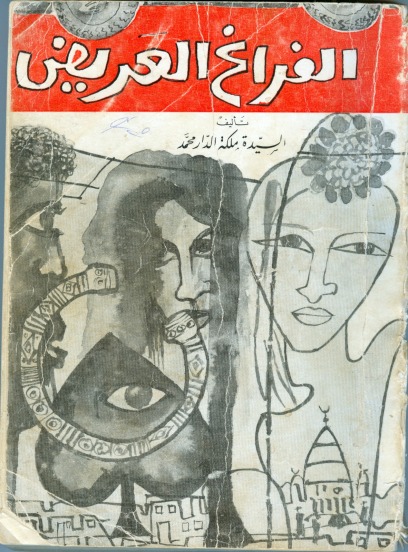How did novelists deploy types in an apparent push to open up gender norms in Sudan?
By Lemya Shammat

In his book The Candle and The Darkness (2004), and in an intriguing article entitled “The Face and the Mask, Female Creativity / The Mirror of the Innermost,” Mohammed Al-Mahdi Bushra uses textual analysis to interrogate gender concerns and the use of gender stereotypes in Sudanese fiction, drawing examples from both classic and contemporary literary works.
Malkat Addar Mohammad’s الفراغالعريض (The Wide Void) was the first novel by a Sudanese woman that was published in Arabic. Written in the early 1950s, it was only published in 1972. Al-Mahdi selects this work to set a stark example of the hurdles that creative women faced in a then-strictly codified society, where female creative endeavors were met by suspicion, disavowal, and dismissal.
However, Malkat Addar Mohammed (1920-1969)—as a pioneer of the literary feminist renaissance and a woman of spirit and courage—was emboldened rather than deterred by the demoralizing feedback. She persistently continued to illustrate, through her successive literary works, the deeper currents at work beneath the surface of gender expectations in her particular sociocultural context, which subtly worked to shape perceptions and presuppositions. She reflected on the inevitable consequences that befall women who defy the conventional gender norms and sociocultural tags and choose to push the boundaries so as to lead a fulfilled and purposeful life.
Throughout Malkat Addar’s narratives, where women characters are central and influential, unjust sociocultural rules and norms are called into question. Here, women are cruelly objectified, deprioritized, dehumanized, and otherized. She repeatedly zooms in on the life-changing potential and the infinite possibilities and opportunities women mighthave had if they’d been daring enough to step onto a different path, empowered by education and unbending will. The themes of her carefully crafted fiction seem to strike a chord beyond the confines of the culture and to ring painfully true, as women started to recognize their own experiences in her creative expression.
Malkat Addar unrelentingly utilized the transformative power of language to further navigate more turbulent waters, as she depicted the grim realities of women and the deeply felt injustices in an oppressive patriarchal society. This manifested itself in the negative portrayal of male characters, who tended to be described as self-centered, opportunist, dysfunctional, dishonest, and untrustworthy.
Bothina Khidir Makki, has also, according to Al-Mahdi, tackled similar themes, where female characters are dominant, while males are unsympathetically portrayed in stories like “The Taste of Clay” and “Ten Dirhams.” The narratives represent unfaithfulness, polygamy, and maternal obsessions as major threats that disproportionately and viciously impact women.
Stella Gaitano is another iconic female literary figure who doesn’t shy from interrogating problematic aspects of Sudanese cultures, and from articulating the inequalities women have experienced in the domestic sphere and in society at large, where Injustice is deeply entrenched. Male characters in her earliest works sometimes appear as unwise, naïve, and weak-kneed, as depicted in A Lake the Size of Papaya Fruit.
Al-Mahdi correspondingly interrogates representations of gender in Abu-Bakr Khalid’s (1935-76) narrative. Conversely, female characters are appreciatively portrayed as assertive, poised, independent-minded and self-confident. Endurance and resilience are considered as innate female characteristic. In The Beginning of Spring (1958), Zinab, the female protagonist, is drawn as a young woman with soul-searching questions, who refuses the shackles of traditional arranged marriage and determinedly decides to choose education. Similarly in The Bitter Spring(1966), Fathia steps outside the conventional gender roles and boldly shoulders the responsibility of her family instead of her weak and hesitant brother, and works hard to steer their life to a better place. She assiduously seeks enriching, mind-broadening and horizon-expanding life experience.
In twentieth century novels, abusive and negative characters in women’s writings are used as a loud cry of protest against oppressive patriarchal domination, where women are systematically subdued, burdened, and disadvantaged, whereas a positive self-image—including in men’s works, such as Khalid’s—is deliberately used to challenge gender ideology and to bring new expectations and possibilities to their literary experience. Elevated portrayals of women are shared among writers of both genders to redefine a woman’s image and open prospects for new bold endeavors.
Essayist, short-story writer, and critic Lemya Shammat has a PhD in English Language and Linguistics from Khartoum University and is an Assistant Professor at King Saud Bin Abdul Aziz University in Jeddah, Saudi Arabia. A member of the Sudanese Writers Union, Shammat has published a book on literary criticism and discourse analysis as well as a collection of short-short stories. She also translates between English and Arabic, and her work appears in ArabLit Quarterly.
Click HERE to read more from this author.
You can publish this article on your website as long as you provide a link back to this page.

Be the first to comment